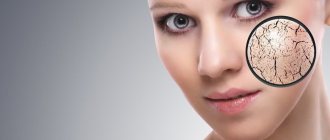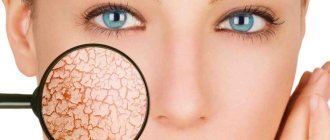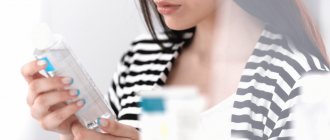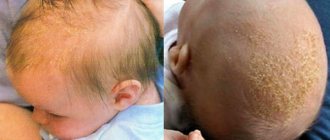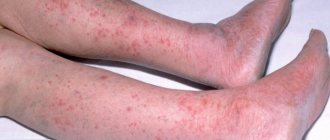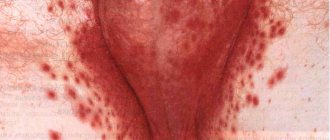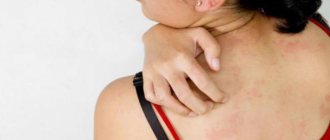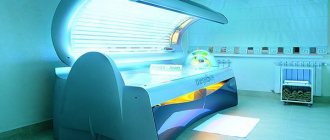Author: Pushkina Natalya Vladimirovna
, dermatovenerologist of the first category, practicing trichologist, member of the Union of Trichologists and the Eurasian Association of Trichologists, teacher at the Nautilus School of Trichology
Seborrheic dermatitis is a serious scalp condition. The scalp peels intensely, a person is constantly bothered by itching, and there is a need to wash the hair frequently to prevent this active peeling. Inflammation may also accompany these manifestations. This problem must be solved comprehensively: properly cleansing the scalp, soothing it, moisturizing it, so that the problem does not reappear.
Seborrheic dermatitis. Terminology
Seborrheic dermatitis
- a chronic inflammatory skin disease associated with an increase in the quantity and change in the quality of sebum, as well as with the influence of skin microflora.
The composition of sebum includes glycerides (more than 40%), free fatty acids (16%), wax esters (up to 25%) and cholesterol, squalene (12%) and cholesterol. Triglycerides in sebum are broken down into free fatty acids by bacteria. Some of them form volatile fatty acids that impart odor to the skin. Sebum itself has no odor.
The wide prevalence and constant increase in incidence determines various approaches to treatment, the main goal of which is to achieve a long-term positive result.
Manifestation of seborrheic dermatitis:
1) thickening of the stratum corneum, peeling;
2) oily sheen, seborrhea, sebostasis (stagnation of sebaceous secretion at the mouth of the hair follicle);
3) inflammation of the skin;
4) itching.
Seborrheic dermatitis affects those areas of the scalp and body where the sebaceous glands are most developed:
- scalp,
- anterior chest area and interscapular area,
- area of the ears,
- forehead,
- nasolabial triangle.
When the skin of the scalp is affected, thinning and thinning of the hair is observed. In severe cases, seborrheic dermatitis can have the character of a widespread exfoliative process up to erythroderma.
| Dandruff = seborrheic dermatitis | Brightness of blood vessels - inflammation |
Folk remedies
If the disease is not advanced, you can get rid of it with the help of alternative medicine, or combine such methods with medical prescriptions.
Henna
It is one of the most popular remedies in the fight against dandruff.
How to use: pour 60 g of powder with boiling water (you need enough water to get the consistency of sour cream), then cool. You can also dilute the ointment with rosemary and/or tea tree essential oils. Apply to affected areas for half an hour and rinse with warm water.
To prevent your curls from becoming colored, it is better to use colorless henna. The recipe can be supplemented with a decoction of St. John's wort, apple cider vinegar, orange juice, burdock oil, and blue clay.
Unripe (green) walnut
Option #1. 100 g of crushed nut shells are poured with vodka (0.5 l) and infused for 2 weeks. Afterwards the infusion is filtered. Used by massaging into the skin every other day for 20 days.
Option #2. 300 g of crushed leaves, peel and shell are poured into a liter of water and brought to a boil in a water bath. Then the broth is removed from the heat and infused for 2 hours.
How to use: As a rinse after washing your hair. Afterwards, wrap your head in a towel and leave for at least 10 minutes. Repeat the procedure 3-5 times. The effect is noticeable from the first use.
Important. Walnut can dye strands a dark color, so it is better not to use it on light-colored hair.
Kefir
Apply with rubbing movements to the entire surface of the scalp and leave for half an hour. Wash off with rinse aid (1 tbsp dry mustard diluted in 1 liter of warm water). Do it daily for a week. Then repeat the procedure for preventive purposes once a month.
Burdock root
The young root of the plant is crushed (in a meat grinder or grater) and mixed with vegetable oil (1:3). Next, the mixture must be infused for an hour in a glass jar. Then strain and rub into the skin 2-3 times a week. Warm up before use. There should be a total of 10 such rubbings. The next course is repeated after 20 days.
Burr oil
When heated, apply to the scalp. Then the head must be covered with polyethylene, wrapped in a towel and left for 2 hours. Rinse off.
nettle leaves
A tablespoon of crushed leaves is poured into a glass of boiling water. The resulting infusion must be covered, wrapped and kept for 1.5 hours. Strain. Apply to skin after washing, cover head with a bag and leave for 40 minutes. There is no need to wash your curls after the procedure. Use the product twice a week.
Chamomile flowers
Boil table 2. spoons of flowers with 1 liter of water. Cool and strain. Dilute with plain water in a ratio of 1:10 and rinse your hair after washing three times a week. Do 15 procedures, then pause for 3 weeks and repeat the course again.
Chamomile gives light strands a golden hue.
Sage
Infuse for 1 table. spoon of dry sage herb with 1 glass of boiling water for 24 hours. Rub in every other day for a month. This remedy is good for dry seborrhea. For oily dandruff, replace the water in the recipe with a glass of vodka.
Tea tree oil
Powerful antiseptic. For treatment, it is better to add it to shampoo. In its pure form it can cause burns.
Oak bark
For medicinal purposes, you need to prepare an infusion of a tablespoon of bark, poured with 400 ml of boiling water. All this is infused in a water bath for 5 minutes, then filtered. Rub the infusion into the scalp 3-4 times a day, adding a tablespoon of flower honey to the liquid.
Seborrheic dermatitis. Causes
The main causes of this disease are:
1) genetic predisposition;
2) metabolic processes;
3) influence of the external environment.
In 1874, the French microbiologist L. Malassez first hypothesized that the causative agent of seborrheic dermatitis is the yeast-like lipophilic fungi Pityrosporum, which later received its name in honor of this scientist. Fungi of this species are concentrated in the middle and superficial parts of the stratum corneum, inside and between the horny scales, as well as in the hair follicles.
Until now, both names of the causative agents of the disease can be found in the literature: Pityrosporum and Malassezia. Currently, the role of the pathogen Pityrosporum in the pathogenesis of seborrheic dermatitis of the scalp and dandruff has been confirmed by numerous clinical and laboratory studies.
These yeast-like lipophilic fungi are a permanent component of the healthy skin microflora in more than 90% of the population. Fungi concentrate around the sebaceous glands and use their secretions for growth and development. Pityrosporumovale (P. ovale) or according to another classification Malassezia furfur is more often found on the scalp, and Pityrosporumorbiculare on the skin of the trunk.
Drug treatment
If you ask your doctor how to get rid of crusts, he may recommend ointment (applied with a cotton swab), shampoo (frequent washing) or a combination of these products. In particularly advanced cases, antibiotic therapy and other alternative methods are prescribed.
Effective drugs
Sulsena
It is a favorite among other means of combating the problem. The main active component is selenium disulfide. Normalizes the condition of the skin, reduces fungal activity, normalizes the functioning of the sebaceous glands, has an exfoliating effect and restorative properties.
It is used both as a shampoo for scalp crusts and as a paste. Often both remedies are used in combination. The cost of shampoo or peeling shampoo is about 300 rubles, the paste is about 120 rubles.
Naftaderm
The main component of the ointment is Naftalan refined oil. It is used for any diseases that result in the formation of a dry crust on the head of an adult. Use twice a day for a month. The cost of the drug is within 500 rubles.
Attention! It is recommended to combine therapy with emollient creams and oils to avoid excessive dryness of the skin.
Keto plus
The active ingredients of the shampoo are zinc pyrithione and ketoconazole. Effective in the treatment of dandruff caused by Malassezia furfur (yeast microorganisms). The course of treatment depends on the type of disease and is carried out according to the scheme. The cost of Keto Plus ranges from 720 rubles.
Salicylic ointment
It is based on salicylic acid, which has antiseptic and regenerating properties. Softens dry crusts and relieves inflammation. Treatment lasts from 6 to 20 days. Depending on the type of disease and the general condition of the skin, it is used both in pure form and diluted with Vaseline. The most affordable product, the price of which ranges from 25 rubles.
Prevention of oily seborrhea
If it is impossible to eliminate the cause of oily dandruff (for example, with a genetic predisposition to the disease), regular prevention comes to the rescue. The most effective is comprehensive prevention, the mandatory components of which should be:
- proper nutrition. Food rich in vitamin A will help you (carrots all year round, and blueberries in summer), but it is better to eat as little fatty and spicy foods as possible, and also eat less fried foods;
- proper hygiene. It is usually not recommended to wash your hair either too often or too rarely, but if you have oily dandruff, washing your hair daily won’t hurt. It is only important to choose a suitable shampoo that will not irritate the skin and will not provoke the growth of fungus. You also need to air your head and walk without a hat whenever the weather permits;
- medicated shampoo with antifungal components ketoconazole, which is used periodically in courses.
Alternative Methods
Used in especially severe cases.
Photochemotherapy
Comprehensive approach:
- taking special drugs that create fluorescence, psoralens orally;
- exposure to a prescribed dose of UVA.
Depending on the severity of the disease, different treatment regimens are used. They all come down to two phases: cleansing (2-3 sessions per week until symptoms disappear) and maintenance (once a week for a month, can be extended at intervals of once a month).
Important! Photochemotherapy is contraindicated in children. Women should use contraception to prevent pregnancy during treatment.
Laser therapy (physiotherapy)
Prescribed as an additional means of combating dandruff. The treatment is carried out with a laser beam that focuses photons (low intensity light). Photons improve blood circulation and help activate enzyme metabolism, resulting in the restoration of damaged tissue.
Plasmolifting (plasmotherapy)
The procedure involves subcutaneous injections obtained as a result of processing the patient’s blood in a special centrifuge (obtaining plasma rich in platelets and active components). It not only relieves dandruff and itching, but also helps with other hair problems (loss, weakened condition, etc.).
Plasmolifting has a number of contraindications, which include:
- allergy to anticoagulants;
- chronic or acute diseases;
- menstruation period;
- presence of tumors, hematomas;
- autoimmune diseases;
- pregnancy and lactation.
Vitamin therapy
Recommended for vitamin deficiency resulting in dandruff. The complex of vitamin preparations must include vitamins and microelements: A, F, E, B (1–6, 8, 9, 12), H, C, selenium.
How soon can you get rid of
It all depends on the severity of the disease and how carefully the doctor’s recommendations are followed. The general condition of the body also plays an important role.
On average, the effect of treatment is noticeable after 4 or more weeks. By using pharmaceutical and folk remedies, you can achieve stable remission in the fight against the disease. And following a proper lifestyle will prevent dandruff from appearing in the future.
Like any other disease, dandruff is easier to prevent than to treat. But even if a problem appears, you can achieve positive results quickly. The main thing is to see a doctor in time and follow all his instructions.
In addition, the effectiveness of the fight against seborrhea can be enhanced by using traditional medicine recipes and other alternative methods. But all these steps need to be discussed with your doctor. This will help avoid side effects and create positive dynamics of recovery.
Basic methods for diagnosing itching on the back of the head
We can conclude: the skin on the head can itch for a variety of reasons. It is necessary to begin treatment only when you are completely confident in the diagnosis. For example, by taking vitamin supplements, you may not notice head lice and infect others. Diagnosis and treatment of itchy skin is prescribed by a dermatologist or trichologist (hair specialist). Modern diagnostic capabilities allow you to quickly and accurately determine the source of the problem. First, the specialist performs an examination and collects an anamnesis (that is, interviews the patient in detail). Then the following diagnostic measures are carried out:
- a blood test is prescribed for allergenic factors,
- a biochemical blood test is performed, as well as hormone tests,
- bacteriological studies (scalp scrapings),
- for itching of unknown etiology, examination of the endocrine system organs is prescribed.
Read also: Why the labia itch: causes of vulvar itching, treatment
Getting rid of the manifestations of psoriasis
If there is a suspicion of the allergic nature of this disease, then the doctor will prescribe antihistamines. They relieve the itching.
In case of severe damage, medications containing calcium (chloride and gluconate) are used to desensitize the body.
When detoxification is necessary, doctors prescribe absorbents.
If psoriasis is of an autoimmune nature, it should be treated with immunosuppressants.
The disease is well controlled by glucocorticosteroids, produced in the form of creams and ointments. With their help, inflammatory processes are cured, which has a positive effect on the condition of the scalp.
Taking vitamin D and keratolytics has a similar effect.
If an infection of bacterial origin is associated with external signs of psoriasis, antibiotics must be taken.
Video: how to treat dry and flaky scalp
Often, peeling of the dermis of the head is the cause of many disorders that have occurred in the human body. That is, there can be several reasons for the appearance of dandruff, so this symptom should be treated comprehensively. Dermatologists recommend that people facing this problem analyze their lifestyle in detail and find factors that could trigger the formation of scales on the head. After watching the video, you will learn which remedies are the most effective in treating scalp flaking.
